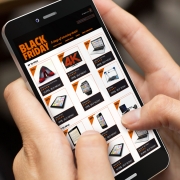In 2016 email marketing has become greater than ever before, and with such high volumes being sent it means it is now more difficult for your emails to reach its final destination – top of your recipient’s inbox. Although there are some businesses that still align their digital marketing strategy with a ‘one size fits all’ notion, luckily most of our clients at Enabler know that when it comes to successful delivery and making sure your emails stand out from the inbox crowd, their email campaigns need to be composed differently.
We’ll show you what to pay attention to when preparing your email campaigns to ensure that you connect with your audiences, composing optimised content that’s engaging, relevant and looks great.
Are you talking to me?
In email marketing, having the right tone of voice to suit your target audience is crucial to a successful campaign. There are varying factors you need to take into account when it comes to what tone to use, which will depend on things like gender, industry, job-role, subject matter etc. If the email campaign is designed to be sent to a decision maker within the engineering industry, for example, they would probably respond better to a factual, technically focused email that’s straight to the point. However, it’s a totally different ball game if you’re in the food industry where your email communications can’t always be direct product promotions. You need to keep your audience regularly engaged with different content, so thinking-outside-the-box provides a welcome distraction to just pushing your product, otherwise your audience will just switch off.
You also need to carefully think about the vocabulary that you use. You need to know your audience and understand the sort of words they are more likely to connect with and respond to. Don’t get too clever – using big sophisticated words might look good on an essay, but in an email it can make some people stop reading, especially if your audience is unsure of what the word means.

Innocent Drinks illustrate perfectly how to keep customers intrigued with their Friday morning email newsletter. In addition to sneaking in product-related information, there are always plenty of interesting, entertaining articles and sometimes a humorous take on recent affairs that’ll make even the grumpiest person smile on a Friday morning. Plus, with plenty of freebies hidden within the campaign, Innocent Drinks have managed to promote their brand/product with an indirect, fun email that keeps their consumers engaged and generates great response rates.
Why? It’s relatable to their target audience.
If the same style of email was sent to engineers within the aviation industry, the response rate would be much-lower as the tone is completely wrong for that audience, which would have meant the amount of ‘unsubscribe’ requests would have been greater, which inevitably affects future deliverability.
The best advice is to know your audience, get to understand how they respond and choose your content and vocabulary appropriately to suit them.
B2B or B2C? That is the question
Although both consumers, the main difference between B2B and B2C customers is the buying cycle, and this difference means your emails need to be targeted differently also.
B2B customers tend to take more time to make purchasing decisions due to the fact that there are usually several decision-makers involved in the process. Thus, your email content needs to be informative and consist of enough facts and key details to help all those decision-makers make a decision, and providing them with extra information which they can pass on is a great way to do that; such as whitepapers, case studies or findings from company surveys which in turn enable your company to be seen as an industry leader.
B2C customers usually make quick, impulsive and emotion-based purchasing decisions and they usually do not have to consult anyone prior to making a purchase.
One of the key differences between B2B and B2C emails is Send Time, and if you get this wrong it can have a huge impact on your response rates and ROI. B2B customers are working customers. Despite the workaholics who check their work emails at the weekends, most B2B customers are more likely to respond to email marketing campaigns sent during working hours. B2C customers on the other hand will be checking their emails outside of work hours, which means the best time for response rates are during their commute (before or after work), lunch breaks, evenings and weekends. All of this means your send days and times will vary widely depending on whether you are sending to a B2B or B2C consumer, so again, know your audience and change your content and send times accordingly to maximise your response rates.
Prospective, New or Existing? No two customers are the same…
Defining what sort of customer you are communicating with is a crucial factor that many marketers can sometimes forget when composing their email campaigns. Prospective, new and existing customers all behave very differently towards the email content they receive, and the way that you communicate with them should also be different. Think of it like a journey you want your customers to take; your emails need to be targeted appropriately with the right tone, vocabulary and content that will connect with your audience, encouraging your prospects to turn into new customers, and in turn (hopefully) they will continue the journey to becoming loyal existing customers. Your tone of voice will change as your customers progress through the email journey and you start to build a relationship of trust and familiarity between yourself and your customers. What you don’t want to do is send them email communications that stop the journey in its tracks with content that is irrelevant or inappropriately depending on the type of customer they are and the kind of relationship you have with them. Any relationship you build you should look to maintain and develop further with your email communications, so compose your messages carefully depending on what stage of the ‘journey’ your customer is at.
Another key thing to bear in mind is that prospective customers will need winning over, so you don’t want to send them content that’s going to make them want to unsubscribe straight away. If a prospect has approached you by subscribing to your emails, most customers would expect to receive a welcome or brand introductory email, so if you offer some incentive as a ‘thank you for subscribing’ – such as a white-paper, voucher or event invitation that would be of interested to the new customer and make them feel appreciated and start to build that relationship. As they say… you never get a second chance to make a first impression so make sure you get the right message aimed at the right person first time.
Existing customers already know your brand and are actively doing business with you, but that does not mean you can rest on your laurels when it comes to your emails. It is extremely important not to spam your customers by resending emails with identical content (which is a sure-fire way to get yourself spammed). Most email software allows you to segment customers into groups or categories meaning you can organise your customers and ensure you are delivering the right content to the right people.
Let’s Get Optimised – sizing up your emails for mobile
So we’ve talked a lot about the importance of using varying tones of voice, vocabulary and content to connect with your different customer groups, but another factor that is also important to consider is mobile optimisation. ‘One size fits all’ doesn’t work for your customers, and it doesn’t work for their devices either. Sending an email that looks great on desktop but is misaligned or poorly engaging on mobile or tablets can sometimes be disastrous for your campaign depending on how your users interact with your email communications. Just because you designed your email on a desktop PC doesn’t mean your customers are going to view the email on desktop. More and more consumers (both B2B and B2C) are engaging with emails on their mobile devices, so you need to make sure your content layout and calls-to-action are clear, engaging and correctly placed when viewed on a mobile device. Most email software providers will allow you to view and amend the mobile version of your email campaign, and more sophisticated email software will even allow you to add or omit content solely on the mobile version while still retaining the original content on the desktop version. This is a great way to ensure your emails look uncluttered on mobile and stay concise.
Understanding how your customers interact with your emails is vital. Most email software providers will allow you to gather analytics on what devices your customers are using to view your email campaigns. By looking at this data and learning what device-preference your customers have is really helpful in building effective, engaging email campaigns targeted at your customer base. If over 70% of your customers have a preference for mobile, make sure you include mobile-friendly features such as ‘click to call’ links, and vis versa if their preference is for desktop don’t add too many features that are mobile-only accessible. Don’t disengaging your customers with an email that doesn’t suit the way they interact with your comms.
The key to your email comms is understanding your customer, what words and content they will respond to, understanding what relationship you currently have with them (and what future relationship you hope to achieve), and learning how your customers interact with and view your emails.
We are a race of individuals, so make sure your email communications reflect that. Stand out from the inbox crowd with original content that also treats the customer as an individual. Don’t be generic, be personable and relevant to your audience. Once you understand your audience, you are more likely to create amazing content that will grab their attention and generate a successful campaign ROI.
Track your campaigns and learn from how your customers behave and interact with your communications. Remember, your data is the key to building better campaigns and better relationships with your customers.














